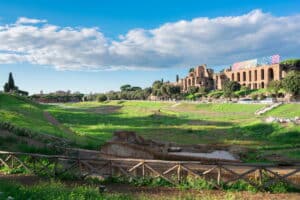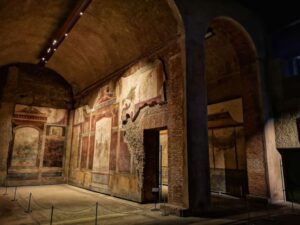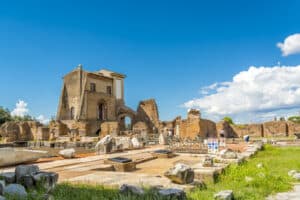
The entrance fee for the Palatine Hill is 18€ for the year 2025. A single ticket is sold for the entrance to the Palatine Hill, the Colosseum and the Foro Romano; separate tickets are not sold. In other words, you must purchase a Roman Colosseum skip-the-line-ticket or tour to enter the Palatine Hill. You can buy a Colosseum ticket to visit the Palatine Hill, or you can choose one of the many guided-tour options and visit it with a tour guide.
The Palatine Hilloccupies a leading place among the seven hills of Rome. It is associated with the legend of the foundation of the city, and has yielded evidence of the earliest settlement in this area, strategically situated 50 m. above the Tiber, near the Isola Tiberina. Under the Empire palaces (the very word “palace” comes from the Palatine) were built here by the Emperors and great aristocratic families of Rome; and although the remains of these buildings give only a very inadequate impression of their former magnificence, a walk over the Palatine nevertheless takes us into the heart of Roman history.

Politicians such as Agrippa, the great art patron, and writers including Cicero had houses on the Palatine. Augustus, who was born here, enlarged his father’s mansion, and under Augustus and his successors a whole series of splendid palaces, temples and public buildings were erected, reaching in the reign of Domitian the form in which we see their remains today. Since each generation carried out alterations and rebuildings it is now difficult to disentangle the different periods of construction.
During the Middle Ages the splendours of the Palatine fell into eclipse. Numbers of convents and churches – the oratory of Caesarius, Santa Anastasia, Santa Lucia, San Sebastiano – were built over the remains of the pagan buildings, and the noble Frangipane family used them to establish a fortified stronghold. In the 16th c. wealthy families, including the Ronconi, Mattei, Spada, Magnani and Barberini, laid out gardens and vineyards on the hill, and Cardinal Alessandro Farnese commissioned famous architects to give the Palatine park its final form.

Circus Maximus – Palatine Hill
The Palatine began to attract archaeological interest in the 18th c. The names of many buildings on the Palatine were known from the works of Roman writers, but some buildings of major importance could not be located on the ground, and even today have not been found. The Palatine was frequently ravaged by fire; and as a result of these and other vicissitudes in its history it is now reduced, like the Forum, to a great field of ruins – but highly impressive and evocative ruins. The most important and most interesting of the structures on the hill are described below.
Access to Palatine Hill
There are four routes of access to the Palatine. The first leads from Via San Gregorio Magno through the gateway designed by Vignola as the entrance to the Farnese Gardens. The other three start from the Forum: the Clivus Capitolinus, which leads past the Arch of Titus; the flight of steps at the House of the Vestals; and the large vaulted passage at Santa Maria Antiqua.
Parts of Palatine Hill
Temple of Cybele
The Temple of Cybele (or of Magna Mater, the Great Mother) in the Farnese Gardens was built in 204 B.C. to house the “Black Stone” of the goddess, following guidance given by the Sibylline Books. Rock-cuttings found in front of the temple represent the earliest evidence of human settlement on the Palatine (9th-8th c. B.C.), a dwelling site of the early Iron Age which has been christened the “House of Romulus”.
House of Livia
The House of Livia (Augustus’ wife) was part of the palace of Augustus and is so called because the inscription “Livia Augusta” was found on a lead pipe in one of the rooms. Augustus himself may have lived in these apartments.

Palace of the Flavians
The ruins of the Palace of the Flavians lie in the centre of the Palatine hill. Built by an architect named Rabirius at the end of the 1st c. A.D. for the Emperor Domitian (a member of the Flavian dynasty), the Domus Flavia was designed to provide a setting for the increased splendour and display which the Emperors now demanded. The building undoubtedly met these enhanced requirements, with its large pillared courtyard (peristyle), the spacious dining-room (triclinium) to the S, the throne room (aula regia) to the North, a rectangular hall 30-5 by 38-7 m with an apse at one end, the shrine of the domestic gods (lararium) and a basilica which probably served as a law court.

Flavian Palace
House of Augustus
The House of Augustus seems to have been not so much the house of Augustus himself as the residence of the Imperial house (augusta). Although not yet fully excavated, this building of two and three storeys is still immensely impressive, with its monumental and yet harmonious dimensions. Built, like the Palace of the Flavians, in the reign of Domitian, it was at first the residence of successive Emperors but later, right down to Byzantine times, was occupied by high dignitaries of the Empire as their residence and place of work.
Farnese Gardens
The Farnese Gardens were laid out in the 16th c. by Vignola for Cardinal Alessandro Farnese and were completed by Rainaldi. Like the gardens of the Villa d’Este at Tivoli, these gardens, with their terraces and pavilions, their lawns and flowerbeds, their groves of trees and fountains, were designed to provide a kind of stage-setting for gatherings of like-minded people.
The Arcadia literary academy met here in the 17th c, leaving a small hymphaeum as its memorial. The stucco decoration is of interest as well as the fountains themselves. The remains of the palace of Tiberius lie under the gardens. Excavations – still very far from complete – have brought to light remains of an atrium.
Stadium of Domitian
Among the main buildings erected by Domitian (AD 81-96) on the Palatine was his Stadium, a running track 160 m. long and 47 m. across. It is not known whether the public were admitted to the contests and displays in this stadium or whether it was reserved for the entertainment of the Emperor and his personal guests; indeed, it is not even certain whether it was actually used for sporting contests at all or whether it was merely designed as a garden in the form of a stadium. According to tradition St Sebastian was martyred in this stadium.

Stadium of Domitian – Palatine Hill – Rome, Italy.
Baths of Septimius Severus
The remains of these baths are the most imposing ruins on the Palatine. The piers and arches of the building were supported on massive substructures which have outlasted the centuries in massive bulk. Remains of the heating system can still be seen in some of the rooms and corridors.

Baths of Septimius Severus – Palatine Hill
From a rectang ular terrace near the baths there is the finest view of Rome from the Palatine (particularly impressive at sunset), with the Colosseum, the Baths of Caracalla (Terme di Caracalla), the Caelian, the Aventine, the Janiculum and on the low ground below it the Circus Maximus (Circo Massimo), a huge structure which could accommodate 185,000 spectators.

